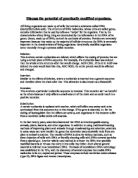The ethical issues of transgenic organisms are very equal. As the advantages of this process is it allows crops to with stand harsh conditions. This allow crops to grow in less developed countries where water and fertile soil is not readily available. Also the transgenic crops will be resistant to insects, which will allow a high yields of the crop, and reduce the possibility of transfer of disease though plants. Also modifications to the crops can increase nutrient content and reduce maturation time.
Animals would also have large advantages to this process for example, if scientists increased the growth rate and allowed larger body sizes for fishes. This would increase the life expectancy of the fish. Also the increase in body size will improve the mating chances for the fish. This will allow an increase in the population of the transgenic fish. This can also be done for cows to increase it productivity of milk.
The ethical problems with transgenic organism are that people feel that animals and plants should not be changed genetically and by people tampering the genetic makeup of animals by mixing genes from other species. Also some people consider that animals would be undergoing large amounts of stress during the process of altering the DNA.
Some people feel there is a health risk by consuming animal genes which are contained in plants or when plant genes are contained in animals. Also the public may consider that there are some unknown side affects which are contained in the transgenic organism. Some people may consider transgenic animals not be natural so they are unable to consume their products
There is very large advantage to the social issues for transgenic animals and crops, which is that there would be a food security for the growing population in many countries. So the public would not have to worry about food shortages.
The problems with the social issues, is that the richer countries may keep the advances in the technology for transgenic organisms for their own financial gain. Also biological bombs could be made using the same process. As new pathogens could be formed though transgenic organisms which have no known vaccine.
The economic issues for transgenic plants and animals are, the original cost for transgenic organism would be very large. This is due to large amount of primarily research, which has to be conducted. This is to ensure the right genes are found, and are inserted in the right place on the DNA on new organism. All this research will be paid by tax pays money, which may aggravate people. As they may feel the money should be spend on more important things,
Transgenic animals can save farms billions of pounds, for example cows are modified to produce lysostaphin which is able to kill the bacteria Staphylococcus aureus which is present in dairy cows. This disease cost the dairy companies £1.6 billion dollars last year.
The environmental advantages of using transgenic crops are conservation of water, soil, and energy. Also it allows better management of natural waste products.
The environmental problems with modified crops, is if the gene which allowed the crops to be resistance against herbicides, was able to enter a weed. These weeds would be resistant to herbicides and a super weed race would have been formed. This would causes greater competition between crops and weeds for nutrients and water contained in the soil, causes the crops to contain a lower nutrient content.
There are very large ecological problems with transgenic organisms. If transgenic animals were released into the wild, they would be better adapted to the environment due to their transgenes. This would make them better predators than their counter parts, which could cause the extinction of some species in the wild, due to lack of food for them.
The future of transgenic organisms looks very good, as the same process could be used to culture human organs in animals like pigs. These organs could be transplanted into humans when needed, which would save many lives.
My view
I feel that transgenic organism if used in the right way and suitable restricts were put in to place would have many benefits to modern society. It could allow less developed countries to grow sufficient amounts of crop and increases the productivity of many different animals.
Bibliography
-
http://
- http://strategis.ic.gc.ca/SSG/tc00045e.html
- http://ens.lycos.com/ens/may2001/2001L-05-07-01.html
- http://www.cals.cornell.edu/extension/nabc/pubs/occ_paper_1/Occ1_toc.html
- A new Introduction to Biology, 2000, B Indge M.rowland M Baker, Hodder & Stoughton
- Exam revision notes, 2000, Bill Indge, philip allan updates
- Biology a functional approach third edition, 1993, M B V Roberts, Nelson
- Revise AS biology, 2000, Rob Ritchie, Letts







